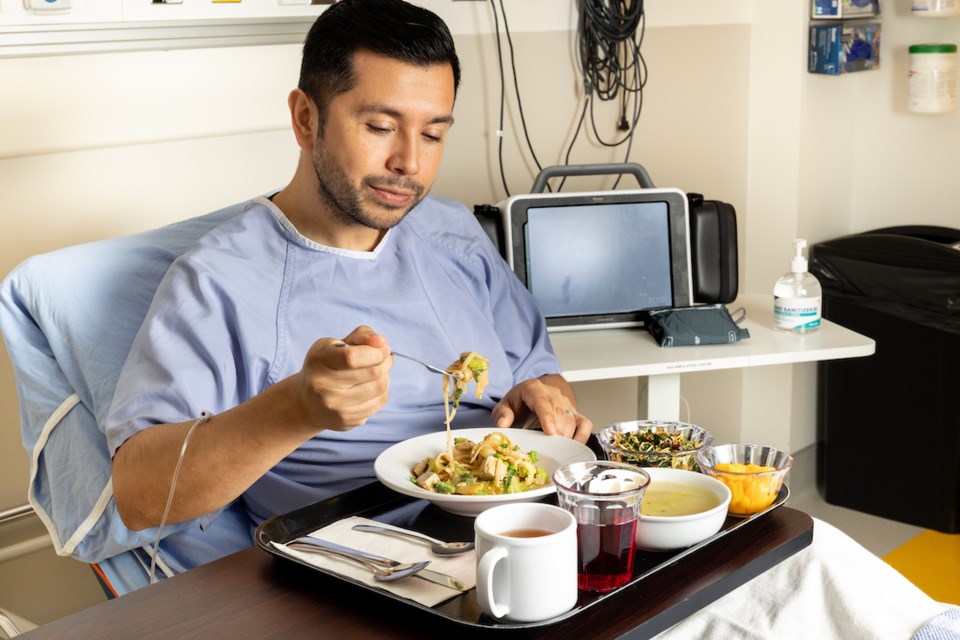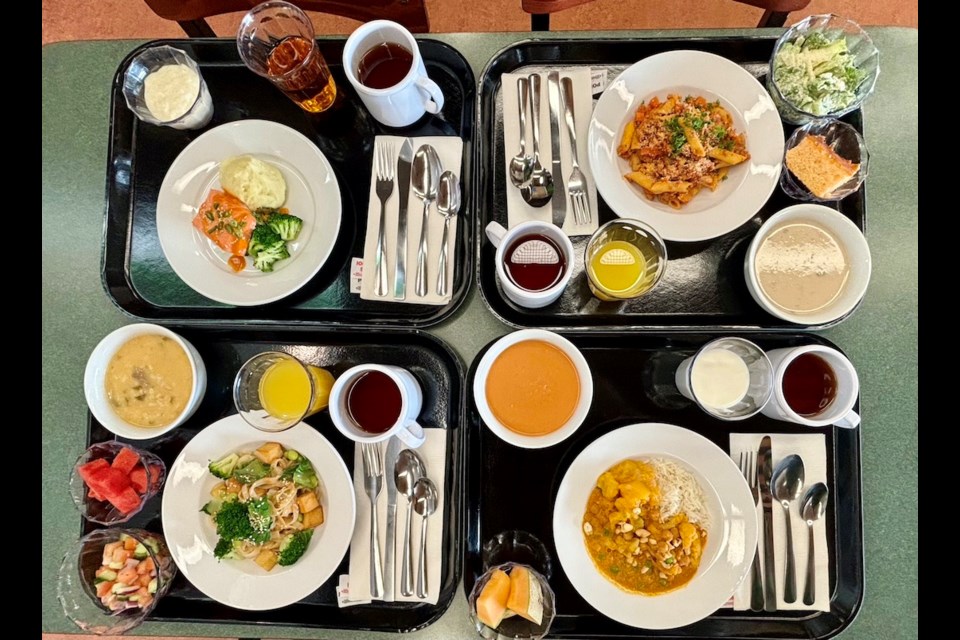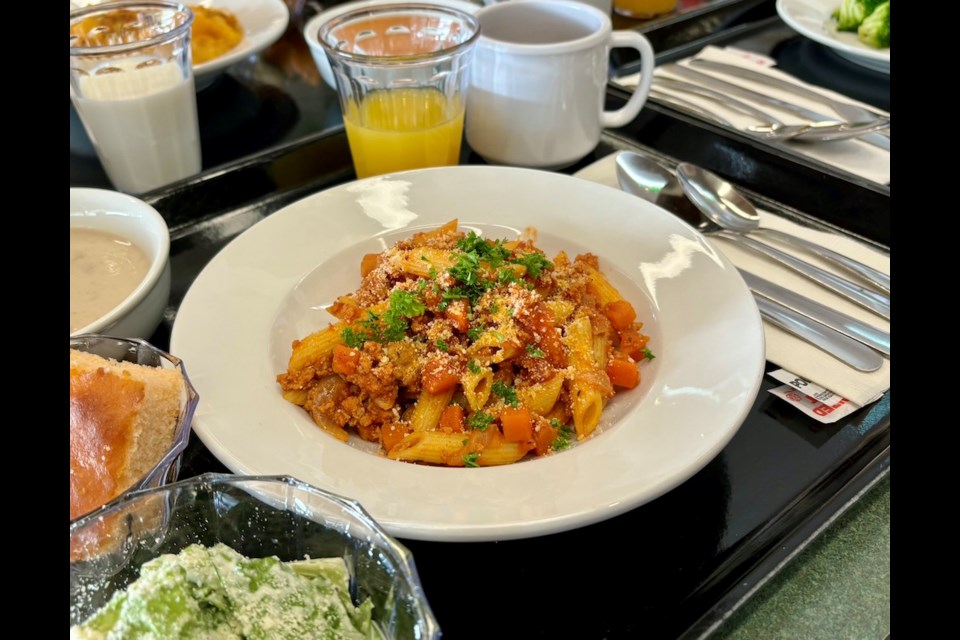There are no sirens or flashing lights in the kitchen at Vancouver General Hospital, but their staff — and several key people — are addressing an emergency: the food.
Not the food that visitors and staff buy, but rather the food that is delivered to VGH's hundreds of patients daily, each of whom is healing from any number of conditions covering a wide spectrum of nutritional needs.
Hospital food, with its rep for being boring, basic and bland, has been a long-overlooked component of patient care.
"We cannot afford to not talk about it," says Ned Bell.
The Vancouver-based chef, known for his commitment to fresh, seasonal ingredients, including sustainable seafood, has been working with VGH for the past few years by way of a pilot program to modernize the hospital's food program.
Patients said they wanted more diverse and meatless options
While VGH has always served healthy food that meets nutritional requirements, over the years, patients have expressed a wish for the hospital's roster of largely Western-based meals to better reflect the diversity of its diners. That means more plant-based options and more global flavours, all in the name of health.
Bell didn't have the state of hospital food on his plate for most of his culinary career until his wife began spending more time at VGH as she underwent cancer treatment. The timing was crucial, as conversations were in the beginning stages of implementing a pilot program to study how food could be improved and factor in cultural and dietary diversity, as well as more eco-friendly choices.
And, of course, being a chef, Bell was keen to find out if hospital food could actually taste great.
Joining a team led by Dr. Annie Lalande, surgical resident and PhD student in the Institute for Resources, Environment and Sustainability at the University of British Columbia (UBC), and Tiffany Chiang, director of food service transformation and strategic projects at Vancouver Coastal Health (VCH), Bell, along with key VGH staff like registered dietitian in acute care Elaine Eppler, got to work on developing new recipes.
Though the pandemic put a hold on the fieldwork, in 2022 the team regrouped to get the Planetary Health menu pilot up and running.
Revamping hospital food menu not the same as in a restaurant
Given the scope of the hospital's food program, and its limitations, as well as the highly specified nutritional requirements each meal has to meet, tackling the menu at VGH wasn't anything like revamping a restaurant menu.
"I had to learn a ton," shares Bell during an in-person menu tasting and info session. "My learning curve was steep."
Starting with an initial batch of 53 recipes, Bell explored all the ways by which he could dial up the flavour, sustainability, and overall deliciousness of existing dishes in the VGH food program.
The working list was narrowed down to about 20 or so lunch and dinner dishes (the team soon realized breakfast items needed the least attention for the time being) and Bell sought ways to make minor adjustments, asking question after question along the way.
Where could ground beef be subbed for ground turkey or lentils? Which ingredients could be sourced from within B.C. at a lower price point, to boot? What could be made in-house rather than brought in packaged? Could a sauce or dressing import offer more flavour in a meal?
Adding garnish a game-changer
But it was the simple addition of garnish to the pilot program's dishes, a practice often reserved for restaurants, that emerged as a game-changer.
What might seem like a minor detail to some has proven to be a significant catalyst in transforming not only the visual appeal of hospital meals but also the overall satisfaction and well-being of patients.
"Sauce and a bit of garnish made a good dish better," explains Lalande.
Lalande explains that the pilot program began by gauging patient feedback through multiple means to discover what people most wanted to see improved. "More flavour," was the dominant response, recalls Lalande, adding that patients spoke up about wanting the ingredients to be fresher and the recipes "more culturally diverse," with more seasoning and texture.
Recognizing that crafting scratch-made meals for six to 700 patients a day is no small feat, Lalande says it was essential for the pilot program to look at meaningful solutions with significant impact.
"Unless we take this time to stop and embrace the complexity, it's hard to come up with something that isn't a band-aid solution," she adds, noting that change in hospital systems is so often reactive and not proactive.
Looking at hospital food programs in North America and even as far away as Lebanon for inspiration on how to be more plant-forward and eco-conscious, the changes in the works at VGH are likely "the most progressive in Canada," attests Lalande.
Subbing in plant-based proteins for meat - without shouting about it
While cost is, of course, a factor, the pilot program made certain to keep ingredient choices within the budget, even finding ways to save by using a plant-based protein source over an animal one. Chickpeas, generally, are cheaper than chicken.
"Plant-based proteins do tend to be less expensive," says Lalande.
Oftentimes, offering a meatless version of a familiar dish didn't yield objections.
"We don’t scream from the rooftop that the Sloppy Joe is vegetarian," says Bell.
It simply is vegetarian, which makes it an option for more patients than a beef version.
Popular new meals include a chickpea curry and trout with tomato miso dressing
A not-so-coincidental side effect of embracing more plants, whether it be fresh vegetables alongside a moist piece of fish or lentils in a Sloppy Joe, is that the impact on the environment is lessened. Even shifting to leaner animal proteins, like turkey or trout, are lower-impact options.
It's not exactly an off-label use of the food program, but it's a way VGH has of "giving the planet a seat at the table," explains Lalande.
Bell, who has long championed a "globally inspired, locally sourced" approach to his cooking, says he's never worked so hard on perfecting so many recipes in his career.
Some of Bell's dishes that have emerged as popular favourites have been the Steelhead Trout with Tomato Miso Dressing; Creamy Coconut Chickpea Curry with Cauliflower and Cashews with Mango Chutney; and the Korean Gochujang Bowl.
During the study, patients answered surveys about the meal, and the team kept an eye on how empty the plates were when they came back to the kitchen.
Eppler calls the Planetary Health pilot program "probably the most exciting thing I’ve ever worked on in my 36-year career."
Food is more than nutrients: 'there's also the emotional feeling'
The longtime dietitian describes the constant and nuanced challenges of working with patients who not only have specific dietary needs but also various struggles to eat. Many hospital patients are unmotivated to eat or do not have the strength for rigorous chewing.
However, having food that looks appetizing and hints at the taste and care of home, can go a long way in getting a patient excited about meal time.
What Bell calls those "little touches of home-made," can wind up "encouraging people to eat," describes Lalande.
"Nutrients help with the physical — but there’s also the emotional feeling," elaborates Eppler. Food encompasses so much, she continues: "It’s comfort, memory, healing, companionship, building relationships, respecting culture."
With the pilot program concluded, VGH is preparing to implement a variety of improvements to its food system in the facility, starting with adjustments to its meal ordering and distribution system to work on a hub or satellite model to shorten the distance between patients and their food.
The plan is to continue "with a few of the recipes right away and introducing [some of the] recipes to other VGH hospitals," explains Chiang.
"This work matters," says Bell, who adds he is extremely proud of the recipes he and the team have produced. "There is an opportunity for us to make changes and that is so incredibly powerful."






.JPG;w=120;h=80;mode=crop)